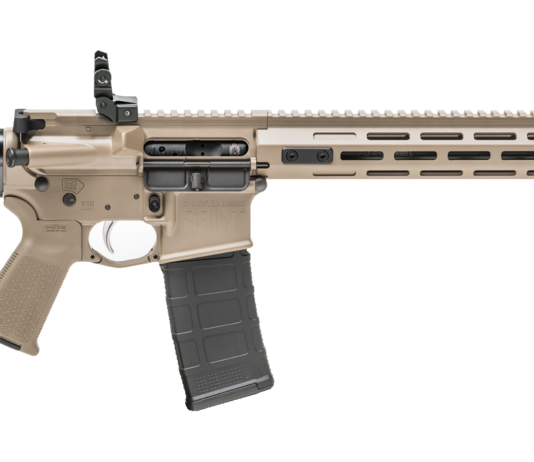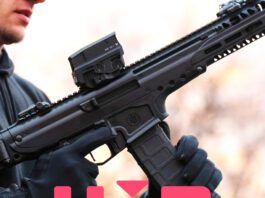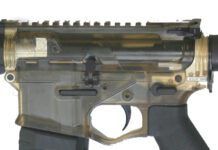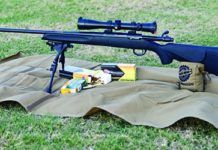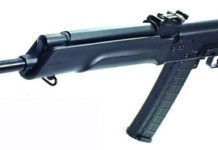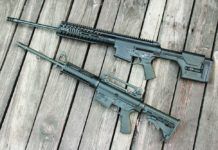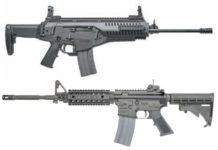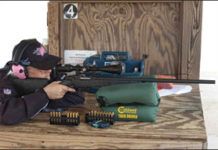Brownells Reintroduces the BRN-601 Retro Upper Receiver
Windham Weaponry Closes Operations
American Tactical’s See-Into-It Translucent Rifle
Tikka T3X Varmint JRTXH312 223 Remington
Ruger Hawkeye Predator 17122 223 Remington
CZ Model 527 03019 223 Remington
Miller v. Bonta Decision
Mid-Caliber Bolt-Action Rifles From T-C, Browning, and CZ USA
Recently, we assembled a panel and arrived at what could be described as a list of practical considerations for choosing an all-around rifle. Not a specialty piece, mind you, but a "daily driver," so to speak. Our test team came up with three considerations we wanted: power, accuracy, and portability. We agreed that in terms of power, we'd like to be able to hunt at least some deer-sized animals, but not with so much power that the rifle was too heavy to carry or generate so much recoil that it was unpleasant to shoot. To us, this meant short-action calibers greater than 223 Remington but less than 308 Winchester. In terms of accuracy, it wasn't long ago that producing a 1-inch group at 100 yards (1 minute of angle) was a high standard. Certainly 1 MOA is still a benchmark, but recent state-of-the-art machinery has made it possible to buy such guns over the counter. And last, but certainly not least, there's portability. Today, that is just as likely to mean aboard an ATV as it is over the shoulder. Either way, slender and compact is still the desired profile. Thus, the focus of this test became four bolt-fed short-action rifles in medium or midrange cartridges. The lineup was as follows:
We had intended to keep the maximum length of our rifles to less than 40 inches, but we decided to include the 41.5-inch-long Thompson Center Compass because we were eager to find out if this $399 rifle chambered for 22-250 Remington had recovered since its sudden recall for safety issues. Adding to its appeal was its threaded barrel, ready for a suppressor or muzzle brake.
Our shortest rifle was also chambered for 22-250. The $859 Browning X-Bolt Micro Midas offered a Grade 1 satin-finish walnut stock with 12.5-inch length of pull and about one additional inch of stock spacers. The Micro also weighed the least, as little as 6.1 pounds unloaded.
In the middle we chose the newest model 557 from CZ USA. The Sporter Short Action chambered for 243 Winchester was perhaps the most traditional rifle, with a checkered walnut stock.
The least traditional rifle, at least in terms of appearance, was the Howa Mini Action rifle from Legacy Sports International. Its multi-cam finish, 6.5 Grendel chambering, and 10-round detachable box magazine set it apart from the others. The right size overall, we hoped the big magazine sticking out the bottom would not make the Howa too difficult to pack.
AK-Pattern 5.56/223 Rifles: We Test Izhmash and Archer
Putting new calibers in old designs is a popular trend, proving you can teach an old dog new tricks. In this test we look at the classic AK-47 platform chambered in 5.56x45mm to see if the new trick would fit the old dog. Matching a new rifle to an old favorite in caliber means keeping fewer types of ammo around the house, so we wondered how the AK would perform with the smaller 5.56mm NATO round to match our favorite AR platforms. Many AR and M4 variants are now available in a range of chambers, from 22-caliber plinkers to 300 Blackout and most things in between, including 7.62x39mm, so this switch works both ways if you want it to. We recently found two AK-styled rifles chambered in 5.56 NATO that we could perhaps upgrade into something better, if the base rifle functioned well enough to consider making the initial investment. Depending on their performance, these two AK-47 variants chambered in the NATO 5.56x45 round might be nice additions to a collection and would make a great companion to an AR in the same caliber.
We found a Polish Archer, imported by I.O. Interordnance, and an Izhmash Saiga Sport, imported by TGI, Inc., of Knoxville, Tennessee, to compete in a head-to-head contest of fit, form, and function, with considerations toward making modifications. Here's what we learned.
DPMS and POF 308 Semi-Autos: Heavy Hitters, or Just Heavy?
The last five years have been a roller-coaster ride for the gun industry, with an emphasis on AR-style rifles, which at one point were sold out nearly everywhere and were often selling above MSRP when you could find them. Now, AR sales are mostly down, except for a segment of the market that seems steadily abuzz, the larger caliber ARs, most commonly the 308 Winchester chambering. Most of the larger population of AR-15 owners can't be sold on the larger chambering simply because of heavier rifle weights, but steadily emerging, is a group of gun enthusiasts who seem not to be deterred by the extra weight. This is evident by the many 308-caliber AR-style guns on the market today made by many gun manufacturers, including Patriot Ordnance Factory and DPMS. These firms are not newcomers to this market; DPMS, in fact, was one of the first companies to develop and manufacture a line of 308 Win. AR rifles about 15 years ago.
We approached this test as if we were already gun owners, and we were considering whether to add a .308 semi-auto to our existing collection to add range above and beyond what our 5.56/.223 semi-autos could develop. So we chose two slightly different configurations to see what seemed like the better mix of weight, handling, and recoil. One of our test guns was a DPMS LR-308-AP4, which has an MSRP of $1269 in its base configuration (with an aluminum free-float handguard), and a suggested retail price of $1399 with an optional free-float quad-rail, as tested here. It is a 16-inch-barrel carbine with a direct-gas-impingement operating system. We pitted it against a Patriot Ordnance Factory Gen3 P308-20 BLK with an MSRP of $2599. This 20-inch-barrel rifle uses a 3-position short-stroke gas piston system to operate the action (your choice of normal, suppressed, and bolt-action operating modes).
We used a three-person test group for this evaluation, all proficient shooters in their area of interest. One was a longtime AR-15 5.56 rifle shooter and collector. The second team member prefers large-caliber bolt-action rifles, and the final member mainly shoots 22 rimfire rifles and pistols. Would trigger time behind either of these 308-caliber AR-style rifles convince them to part with a lot of money to buy one?
Battle Rifles: Berettas New-Age ARX 100 vs. Colts LE6920 AR
If we were a rifle maker with a line of AR-15s, we might put up a neon sign outside our establishment that had an image of our carbine with a simple message below: "Millions and millions sold." Because while that might not quite be true for an individual maker's line, it is certainly true for the ArmaLite Rifle platform collectively. The various configurations of ARs are among the highest-selling rifle designs ever, and their appeal seems to keep broadening, even in the face of political restrictions in some jurisdictions.
Despite this popularity—or perhaps because of it—other designs suited for self defense want to take the AR down a notch, make a little cheddar for themselves at the expense of the standard defense rifle of our time. One such competitor du jour is the Beretta ARX 100, itself an adaptation of the successful ARX 160 military rifle made by the famous Italian gunmaker. The ARX 160 service rifle has shown up in several war zones, and it certainly is not an M16/M4/AR-15 rifle. In fact, the ARX platform has little in common with the AR, which could be a significant hurdle for commercial success, or perhaps the beginning of the next big thing. Which one is what we aimed to find out when we went shopping for a 5.56 NATO-chambered Beretta ARX 100 JXR11B00, $1522, a recent online price for the rifle at TombstoneTactical.com. We put it against a Colt M4 Carbine LE6920SOCOM, $1622, which we recently priced at a Houston-based firearms and floral-design store called Texas Guns and Roses (TexasGunsandRoses.com). This price also includes a $15 handling fee for online orders.
The disadvantage the Beretta had to overcome was that most experienced rifle shooters handle the AR-15 as if it were second nature. To help dial out some of that bias, we assembled a group of both novice and experienced raters for this project, one of whom has fired rifles, but never the AR-15 or the Beretta. With no prior AR-15 experience, we would see how quickly our novice could be brought up to speed on both rifles. Other shooters included a 20-year law-enforcement veteran, whose abstract on carbine training has been published on a federal level, and another rater who is a military captain recently returned from a fourteen-month deployment and a certified NRA instructor. We felt that this mix, along with other interested shooters, would help us pick the best battle rifle.
To test them, we used loads in different weights from several makers. We included Federal American Eagle 62-grain FMJ Green Tips (prior to the recent BATFE attempt at reclassifying them as armor piercing), Hornady 55-grain jacketed soft points, and Black Hills' 77-grain Open-Tip Match. We also fired the Black Hills 52-grain Match, Hornady 55-grain Zombie Max, and Federal's 55-grain JSP and Winchester's 55-grain FMJs. Here's what we found:
























